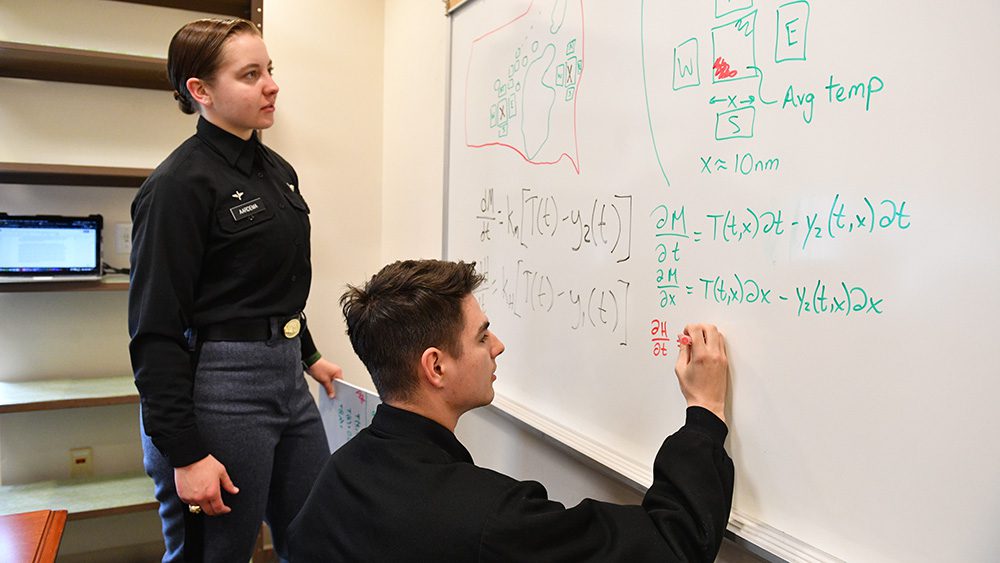Real-World Problem Solving

Kelia Aardema ’20 and Kaleb Francisco ’20 try to mathematically determine where herring will be found in the North Sea when ocean temperatures rise. Photo by Kelly Nye, VMI Communications & Marketing.

Kelia Aardema ’20 and Kaleb Francisco ’20 try to mathematically determine where herring will be found in the North Sea when ocean temperatures rise. Photo by Kelly Nye, VMI Communications & Marketing.
It’s easy to think that for a math major, the capstone or senior year project might involve solving a very complex equation. But in VMI’s applied mathematics department, the capstone course is designed to prepare cadets for a world in which finding the right answers isn’t easy – nor can those answers necessarily be proved mathematically.
In mid-February, all 13 of the 1st Class cadets majoring in applied mathematics competed in the COMAP ICM/MCM competition, which offers students from all over the world the chance to use their mathematical skills to solve a real-world problem. COMAP, which stands for Consortium for Mathematics and its Applications, sponsors the International Competition in Modeling/Mathematical Competition in Modeling each year, and VMI has participated since 2015.
“The students take this competition and they create, in theory, up to a 20-page report in 100 hours,” explained Col. Troy Siemers, Ph.D., chair of the applied mathematics department. “They learn how to tackle an open-ended problem and find good resources.”
It’s stiff competition: Nearly 15,000 teams worldwide compete each year, said Siemers, with only about 10-15% of those teams advancing to the national competition. So far, no team from VMI has ever made it to the national level, but there have been a few honorable mention winners.
“Getting even to that level means you’re in the top half,” Siemers noted.
Normally, the COMAP competition offers entrants a choice of six questions, but this year, COVID-19 resulting in organizers splitting the competition into two weekends, with three questions each. VMI chose to compete in the February event.
One of the February questions had to do with managing a fishery when global warming is encouraging fish to migrate to colder waters, while another involved setting global limits for single-use plastics. The last was coming up with strategies for improvement for a fictional soccer team.
It was the last question that intrigued Cadet Max Stuart ’20 and his teammates, Cadets Zach Shaffer ’20 and Zeac Harris ’20. Stuart explained that he and the others were given a year’s worth of statistics for the fictional team and asked to make recommendations on how to improve their game: “What advice you can give them for better teamwork, what advice you can give for what not to do, what to do,” he noted.
Stuart came into the competition having played fantasy football, and Harris had some knowledge of soccer. Putting their heads together, they were able to come up with a plan for the fictional soccer team.
“We had some really cool findings actually,” he said. “We started off by using this network science kind of thing – kind of a hierarchal passing scheme, seeing who’s getting the ball the most, who’s passing it the most.”
Stuart, who hopes to use his applied math major and physics minor to work in the space industry, said he’d learned a lot from the COMAP competition.
“I really think this project showed me how I could apply my skills in a short time period,” he stated.
“Most of the problems they gave us – if they could be solved, they would have been solved,” he continued.
“Not all of the problems are easy … But it’s more about working with what you have, putting your effort in, and who knows? You may be able to find a breakthrough down the road.”